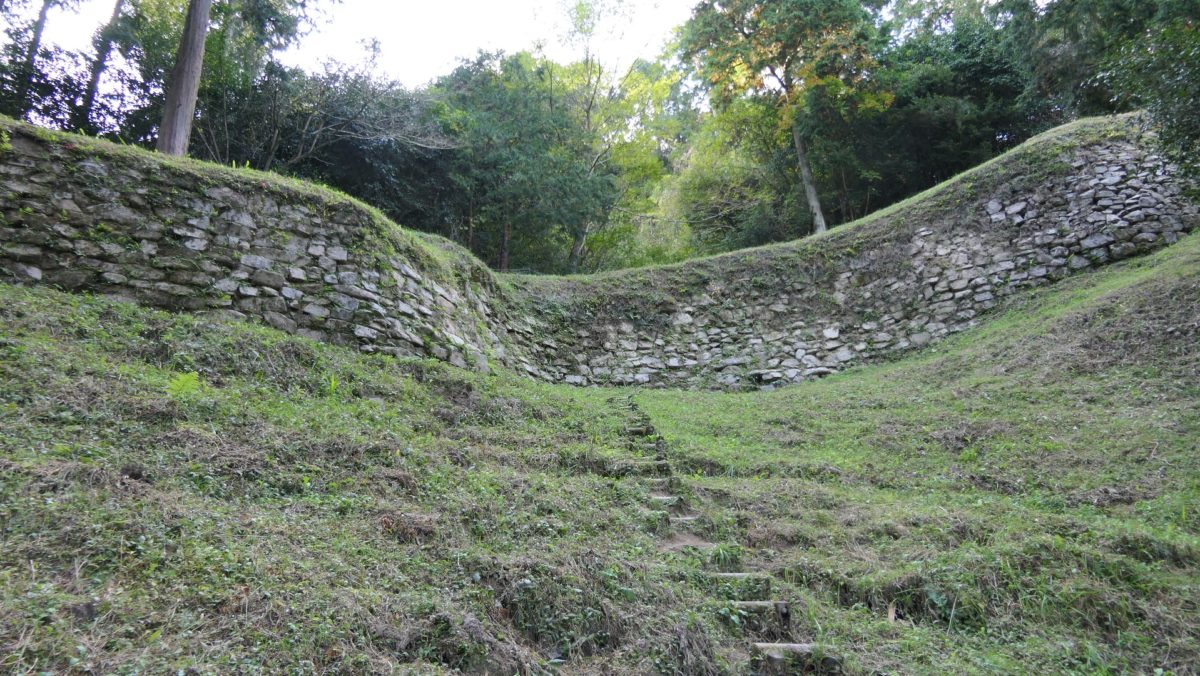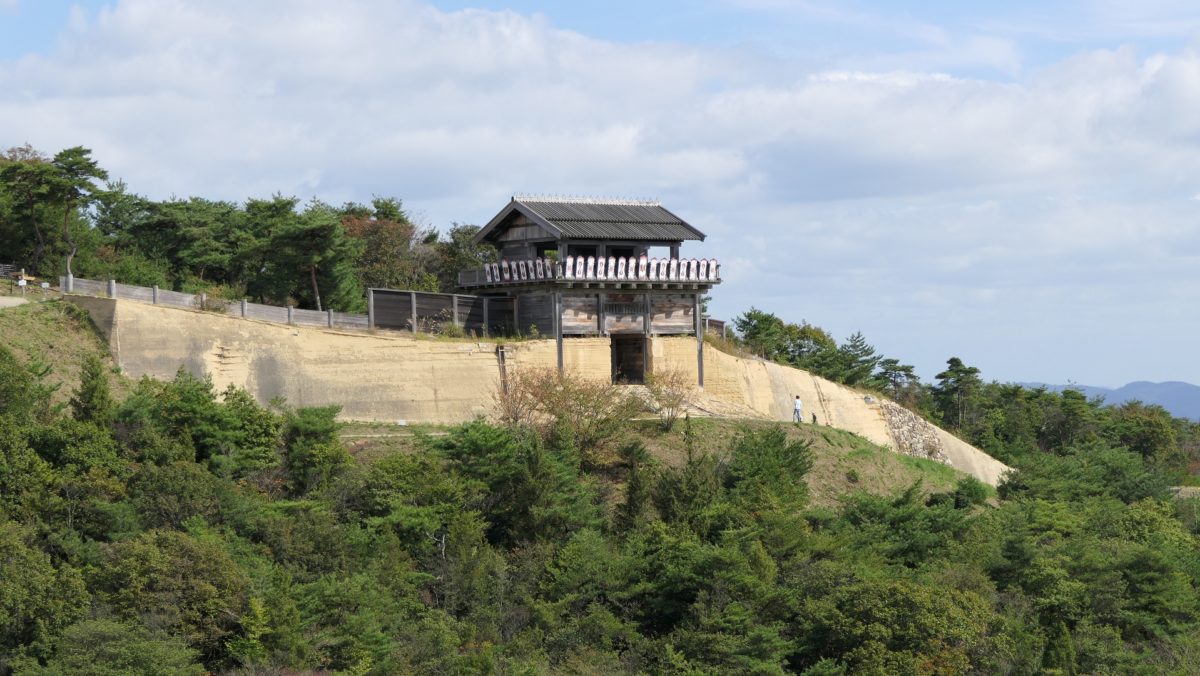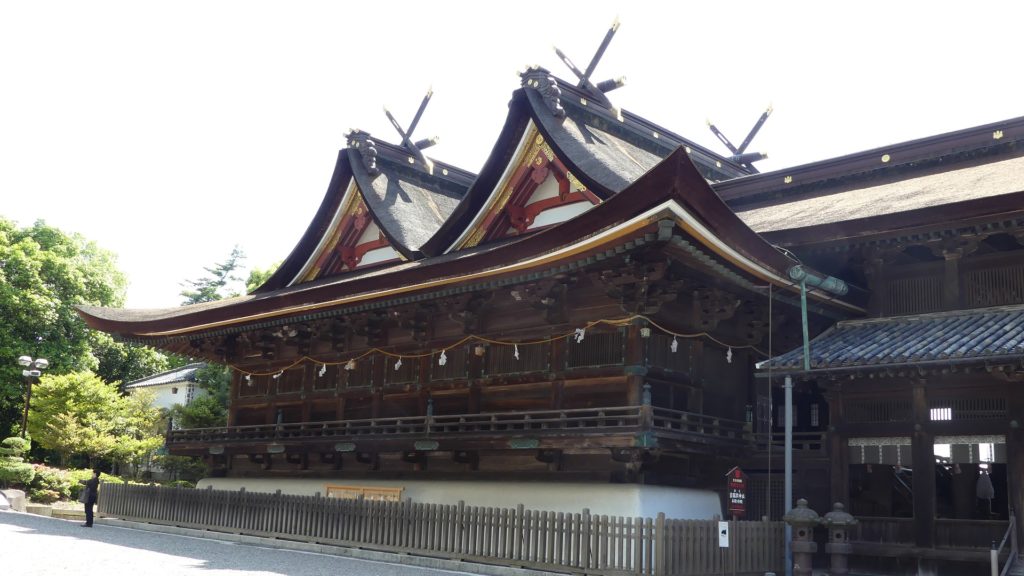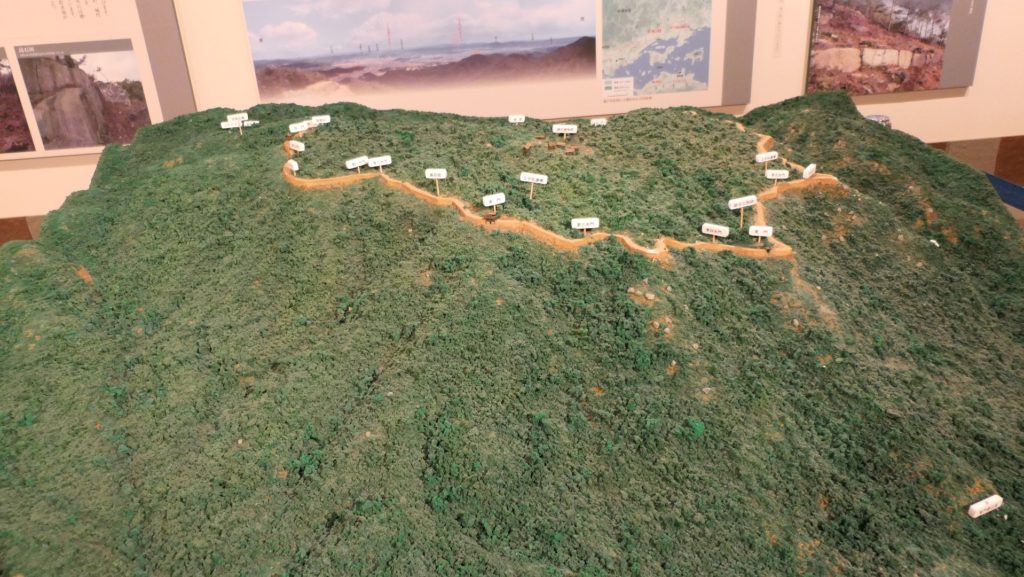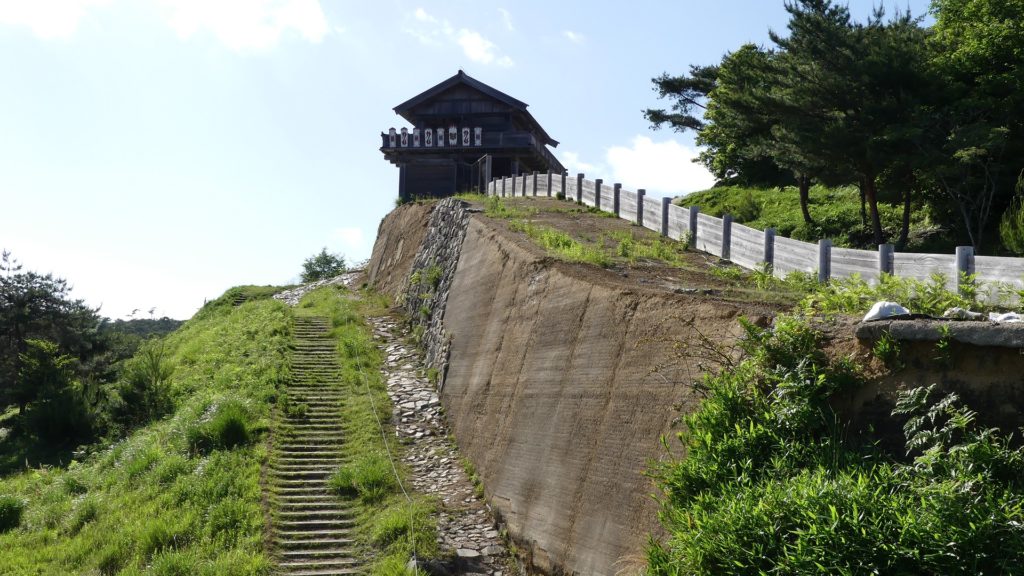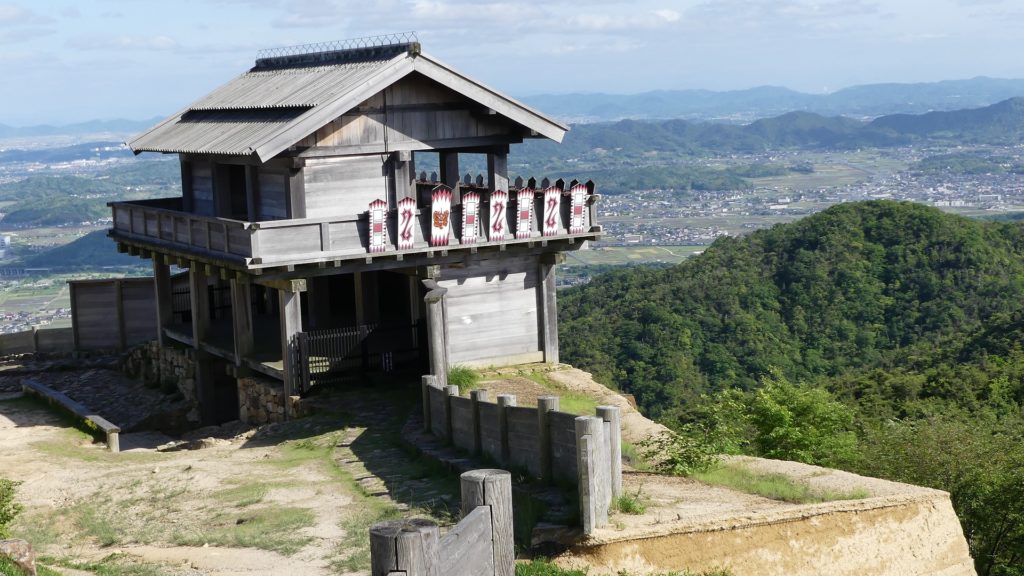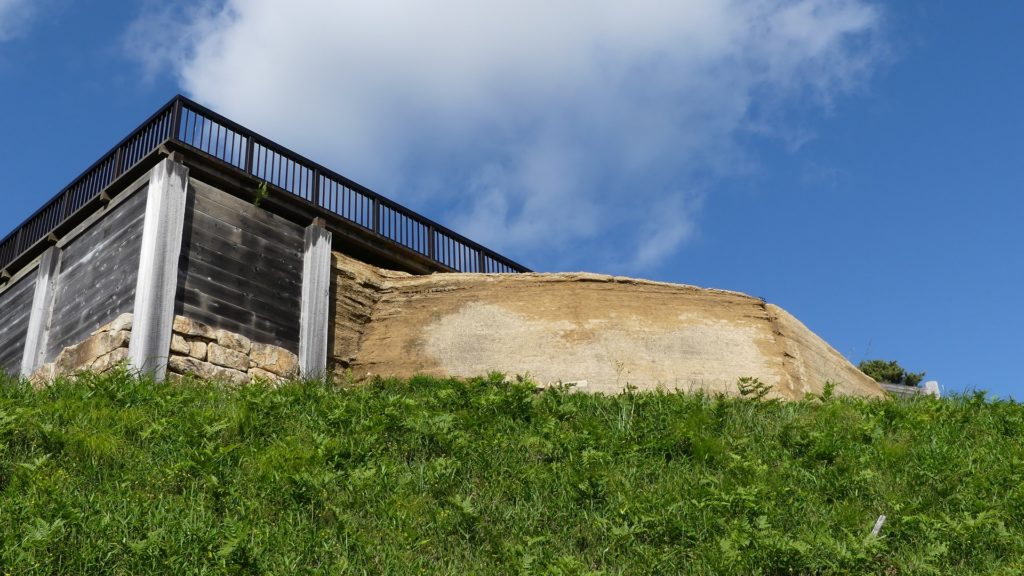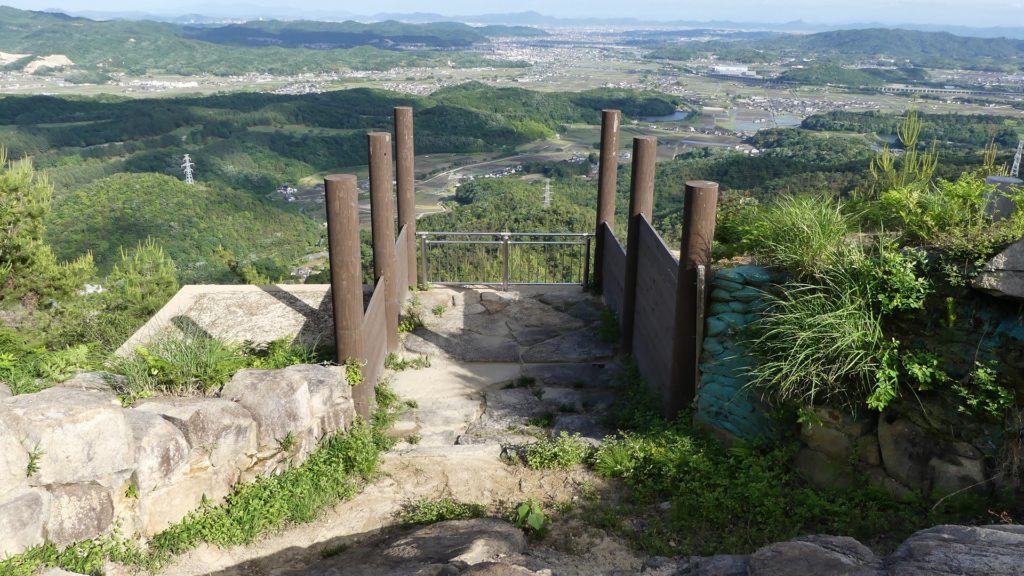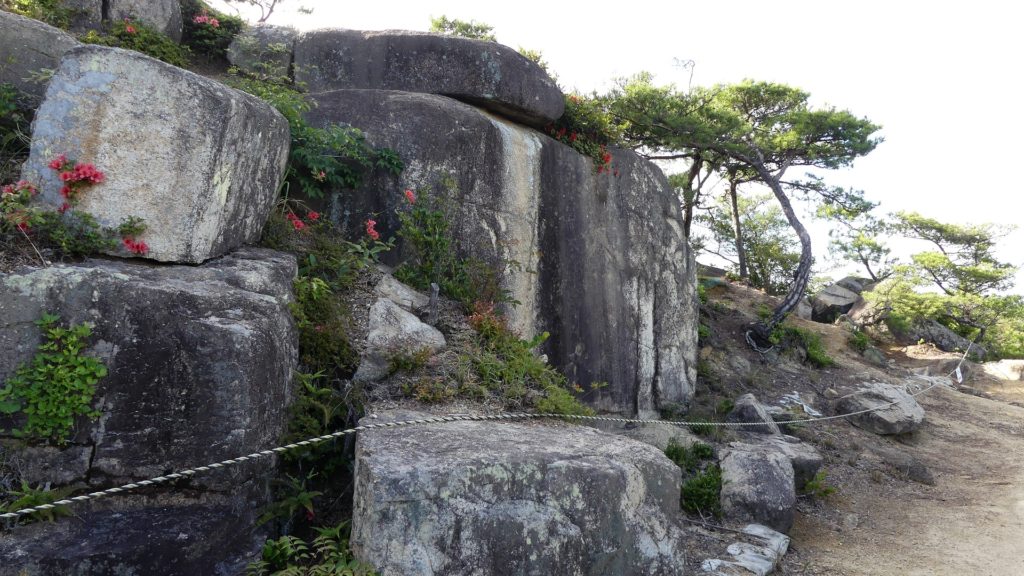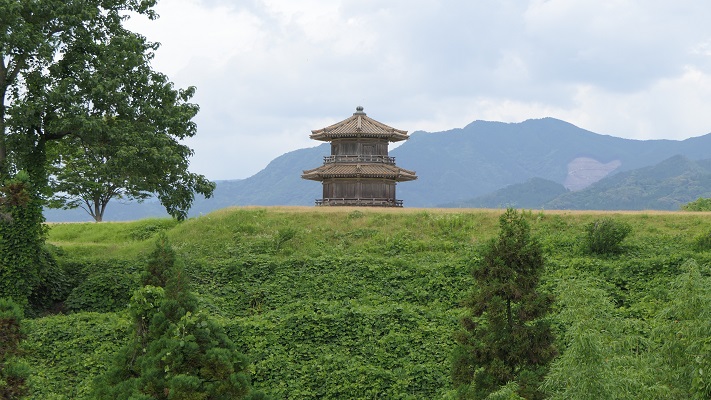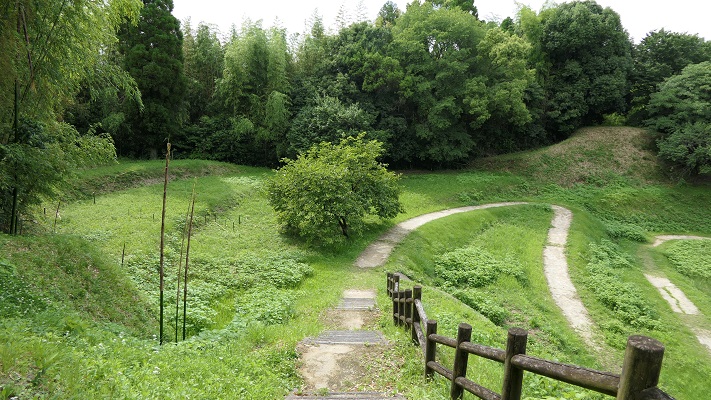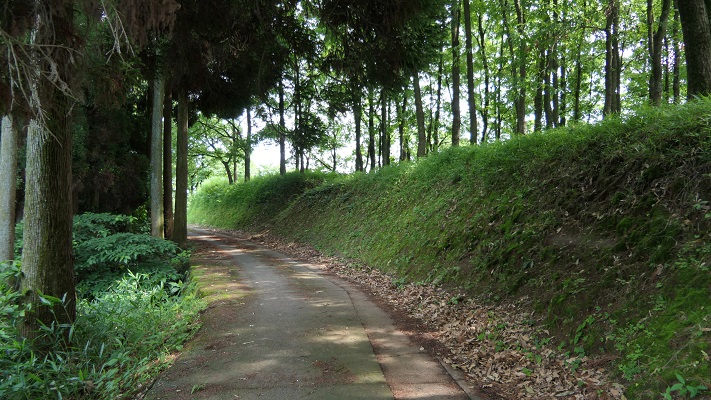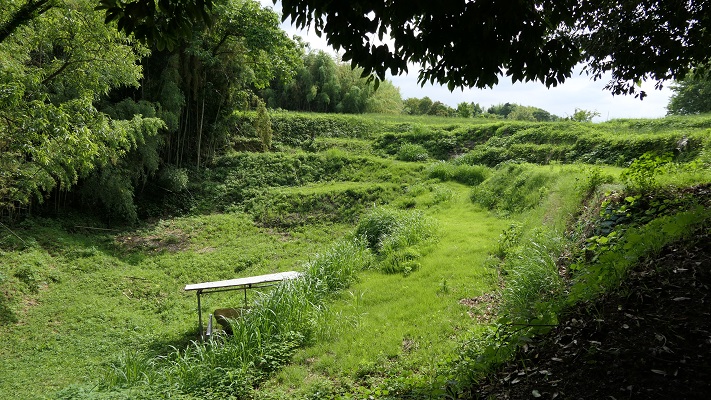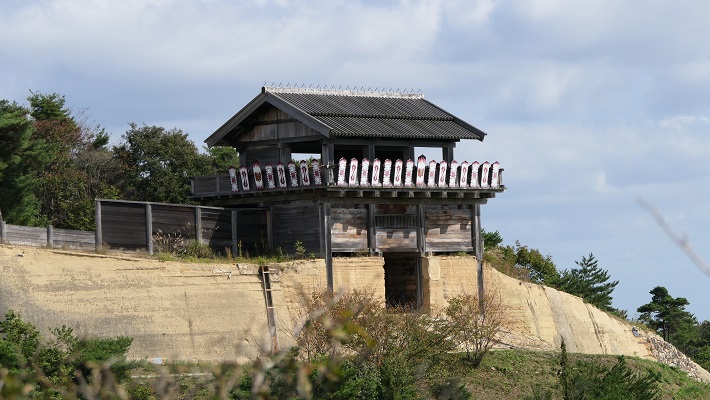立地と歴史~Location and History
古代山城の一つ~One of Ancient Mountain Castles
大野城は西日本にあった古代山城の一つです。663年の朝鮮での白村江の戦いの後、朝廷によって築かれました。日本は百済を助けようとしますが、唐と新羅の連合軍に敗れてしまいます。天智天皇は、連合軍による日本侵攻を恐れました。そして彼は百済からの亡命者の助けを借りてこれらの城の建設を命じたのです。そのために「朝鮮式山城」とも呼ばれています。
Ono Castle was one of ancient mountain castles in western Japan. It was built by the Imperial Court after the Battle of Baekgang, Korea in 663. Japan tried to help Baekje, but was beaten by the ally of Tang and Silla. Emperor Tenchi was scared of invasion by the ally, so he ordered the construction of these castles with the help of the refugees from Baekje. That’s why these castles are also called “Korean style mountain castles”.

これら古代山城は、姫路城、大阪城、名古屋城といった後の日本の典型的な城とは随分見かけが異なっていました。これらの城の主たる構造物は、山の頂を囲む土塁、石垣、貯水池、関門による外郭だったからです。城の内部には官庁、兵舎、倉庫のための建物があったようです。そのため、緊急事態時には平地から避難してきて、敵の侵入を防ぎながら生活と行政を続けられるようになっていました。
These ancient mountain castles looked very different from the typical castles built later in Japan, like Himeji, Osaka, and Nagoya castles, because their main structures were an outline surrounding the top of the mountain with earthen and stone walls, water reservoirs, and entrance gates. There seemed to be buildings for offices, barracks, and warehouses inside these castles, so in case of an emergency, people could escape from plain areas, and continue to live and govern preventing enemies’ invasion.

大宰府を守る城~Castle protecting Dazaifu
大野城は、それらの中で間違いなく最重要の古代山城でした。「大宰府」と呼ばれた古代日本の地方行政府の背後にある「四王寺山」の上に立地していたからです。大宰府は通常、九州地方を統治していましたが、中国や朝鮮に近いため、国家の外交や防衛にかかわる重要な任務にも携わっていました。その庁舎や街並みは、日本の首都に準じて作られていました。
Ono Castle was definitely the most important ancient mountain castle among them, as it was located on a mountain called “Shioji-yama”, behind the ancient Japanese local government, “Dazaifu”. Dazaifu basically governed the area of Kyushu Region, but it also had very important duties, like taking care of Japan’s diplomacy and defense because it is located near China and Korea. The government office and town were built similar to the capital of Japan.

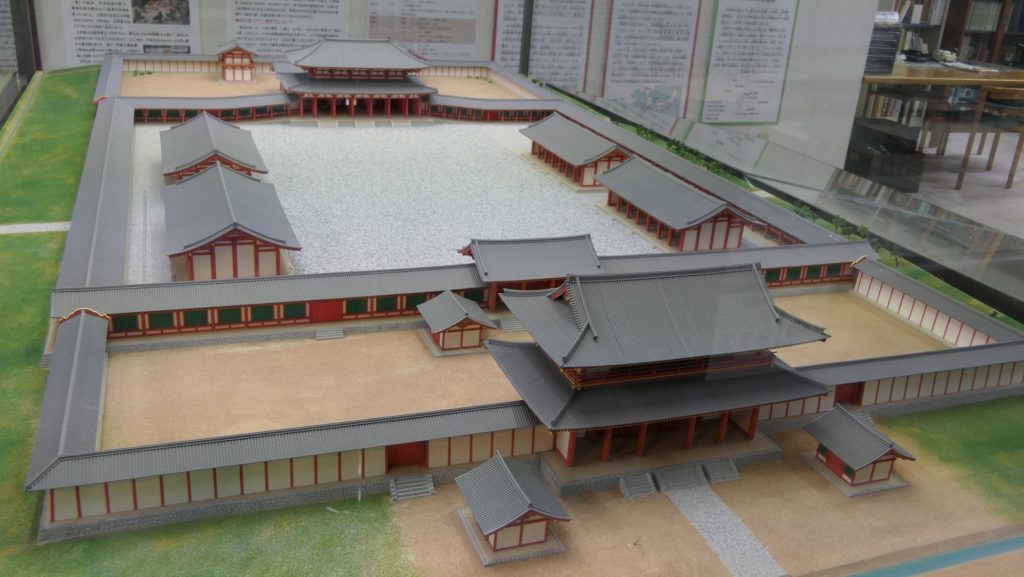
更に四王寺山は山城にもっともふさわしい山でした。その峰が平らな中心部を取り囲んでいるのです。峰を外郭にすることができ、建物を中心部に作ればよいのですが、まだ不十分でした。大量の労働力投入と、百済からの技術者の助けにより、版築という方式で峰に沿って土塁を築き、更には石垣を築き谷を埋めました。外郭の総延長は8.4kmにも及びました。
In addition, Shioji-yama mountain was the most suitable for the mountain castle. Its ridge rounds the flat center. The ridge could be the outline, and buildings could be built at the center, but it was not enough. People made great efforts to build earthen walls along the ridge using a method called Rammed earth, and further build stone walls to fill valleys with the help of the technicians from Beakje. The overall length of the outline reached 8.4km.
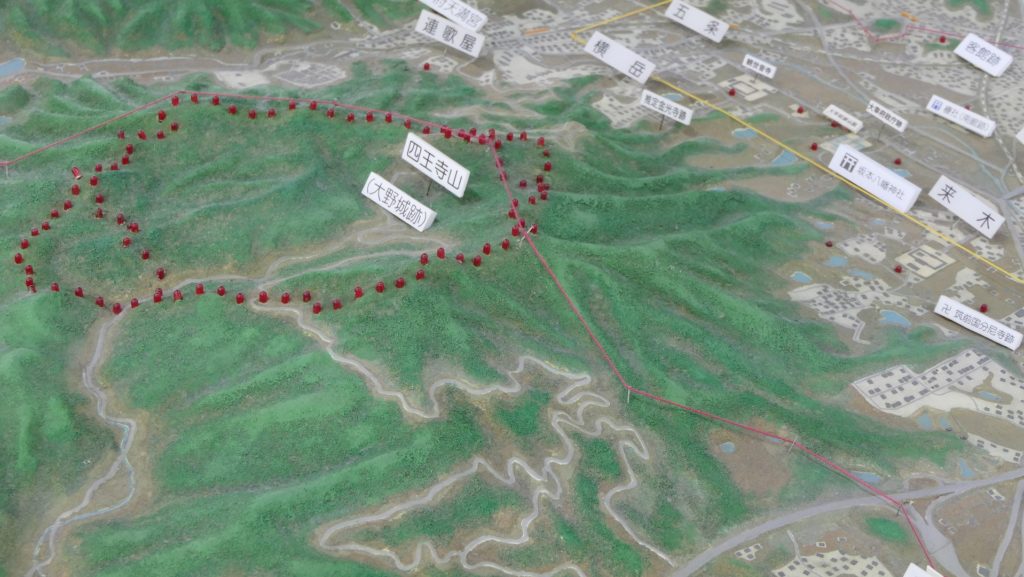
敵は来なかった~Enemy didn’t come
幸いにも連合軍は日本を攻撃しませんでした。日本の古書である「日本書紀」「続日本紀」には、大野城は665年に築かれ、698年に修繕されたとあります。しかしながら、いつしか廃城となってしまったようです。
Fortunately, the ally did not attack Japan. Japanese old history books such as “Nihon-shoki” and “Shoku-nihongi” say that the castle was built in 665, and repaired in 698. However, it seemed to have been abandoned at some point.
特徴~Features
現在、大野城の遺跡は主に外郭に沿って広がっています。そのため全てを見るにはかなりの時間がかかります。今回は、短時間で代表的な遺跡を見て回れるよう2つの地区をご紹介します。
Now, the ruins of Ono Castle are spread mainly along the outline, so it takes a lot of time to see all of them. This time, I will describe two areas where you can see representative ones in a short time.
焼米ヶ原周辺地区~Around Yakigomegahara area
車であれば大宰府天満宮の前から四王寺林道を通って、四王寺山に至ります。そして焼米ヶ原駐車場に車を止められます。そこから歩いていくつかの遺跡を見ることができます。
You can drive from the front of Dazaifu Tenmangu Shrine up to Shioji-yama mountain through the Shioji forest road. Then, you will reach and park at Yakigomehara parking lot. From the parking, you can walk around several ruins.
・土塁線
ここは外郭の南側に当たり、部分的に二重になっています。城の中では重要な地点だったのでしょう。南の方向には街並みがよく見えます。
・The earthen walls line
This is the southern part of the outline, and was partly built doubly. It could be an important spot for the castle. You can have a good view of the town on the south.

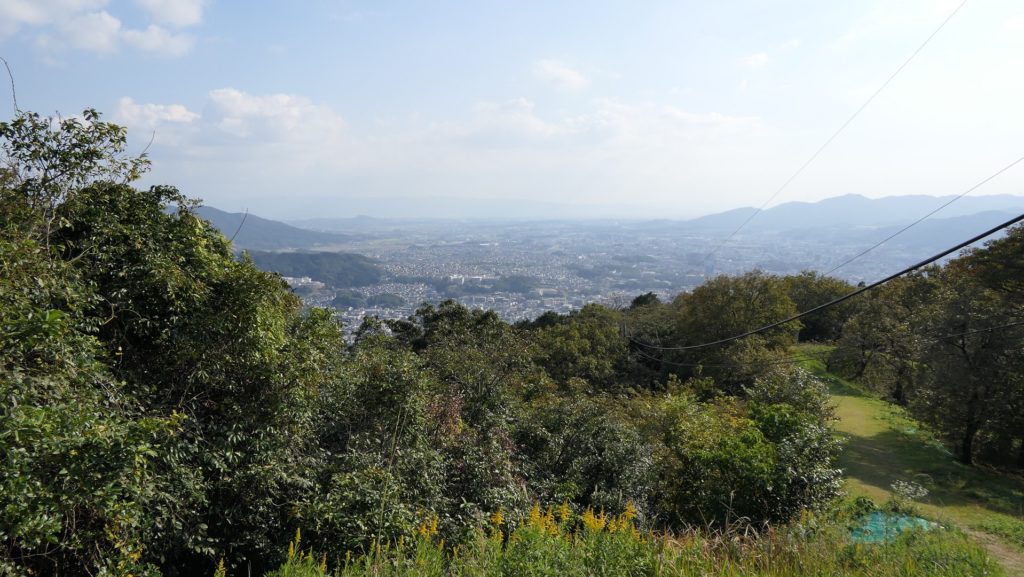
・増長天礎石群
ここは建物の遺跡群のうちの一つです。4つの建物の礎石群が外郭に沿って残っています。今までに70以上の建物の跡が山の上に見つかっています。そのうちの多くは倉庫として使われたと考えられています。
・Zochoten foundation stone group
It is one of the groups for ruins of buildings. The foundation stones for four buildings remain along the outline. So far, over 70 ruins of buildings were found on the mountain. Many of them are thought to have been used as warehouses.
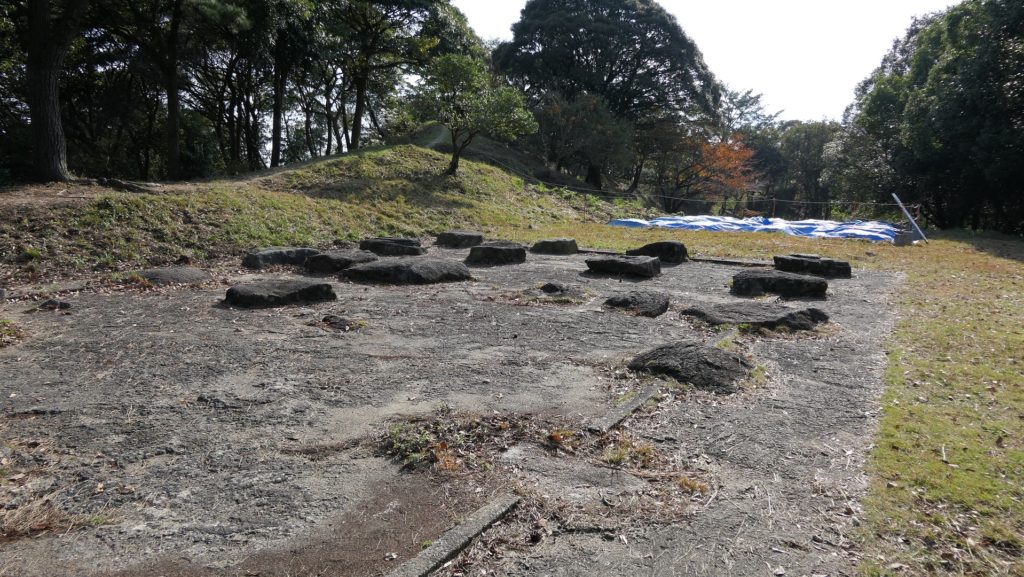
・大宰府口城門跡
これまでに見つかっている9つの城門の中では最大のものです。発掘の成果によれば、この城門は3回作りかえられているとのことです。城の正門であったのかもしれません。
・Dazaifu route Castle Gate Ruins
They are the largest castle gate ruins out of the nine castle gate ruins previously found in the castle. The excavation team found out that the gate was replaced three times. It might have been the front gate of the castle.
太宰府口.jpg)
北部周辺地区~Around the northern area
山の中心の方に行き、県民の森センター前の交差点で右折して進むと、百閒石垣に着きます。道のかたわらに小さな駐車スペースがあります。
You can drive to the center of the mountain, then turn to the right at the intersection in front of Kenminnomori Center, and you will reach Hyakken stone walls. There is a small parking lot beside them.
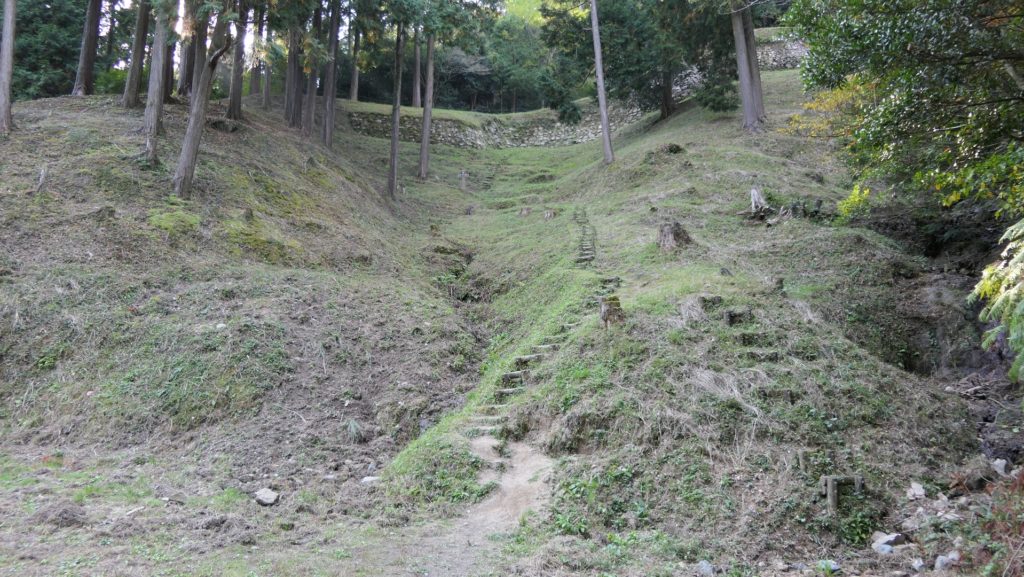
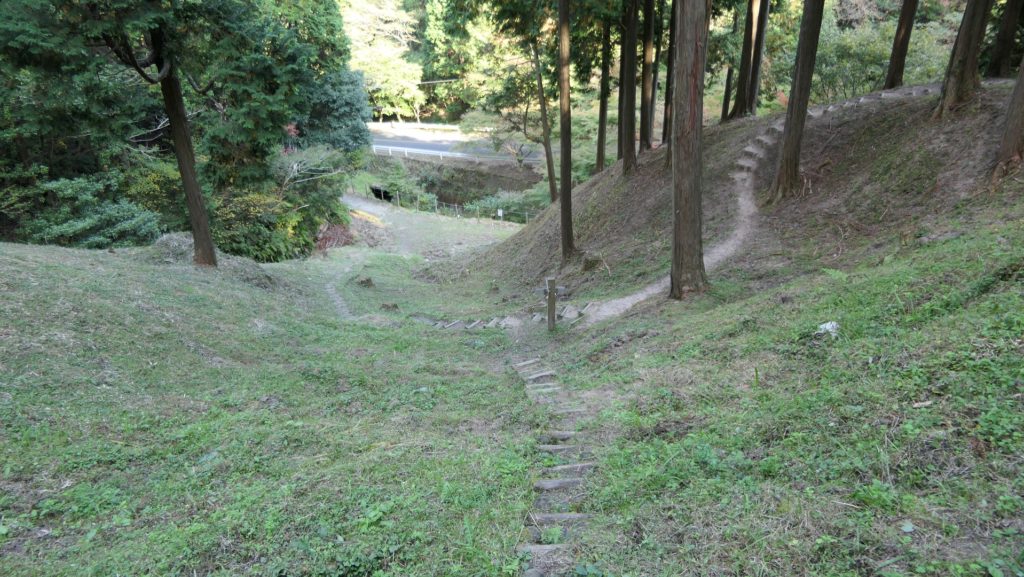
・百閒石垣
この城の中では最大の石垣で、全長は約180mあります(間は日本の古い長さの単位で1間は約1.8m)。この周辺は、城の北の入口に当たり、とても重要とされていました。この石垣は、基礎となる岩の上に、切り出した自然石を注意深く積んでできています。排水のための隙間もいくつか設けられています。朝鮮にはこれと似た山城の遺跡があり、朝鮮から来た技術者が工事を手伝った証拠とされています。
・Hyakken stone walls
They are the largest ones among the castle, which are about 180m across (Hyakken means 100 ken, ken is an old unit of length in Japan, 1 ken is about 1.8m.) and about 8m high. The area around was the northern entrance of the castle, and was considered very important. The stone walls were piled with chopped natural stones on the base rock very carefully. They also have some gaps that can drain water. There are similar stone walls of mountain castle ruins in Korea. That’s because technicians from Korea helped with the construction.


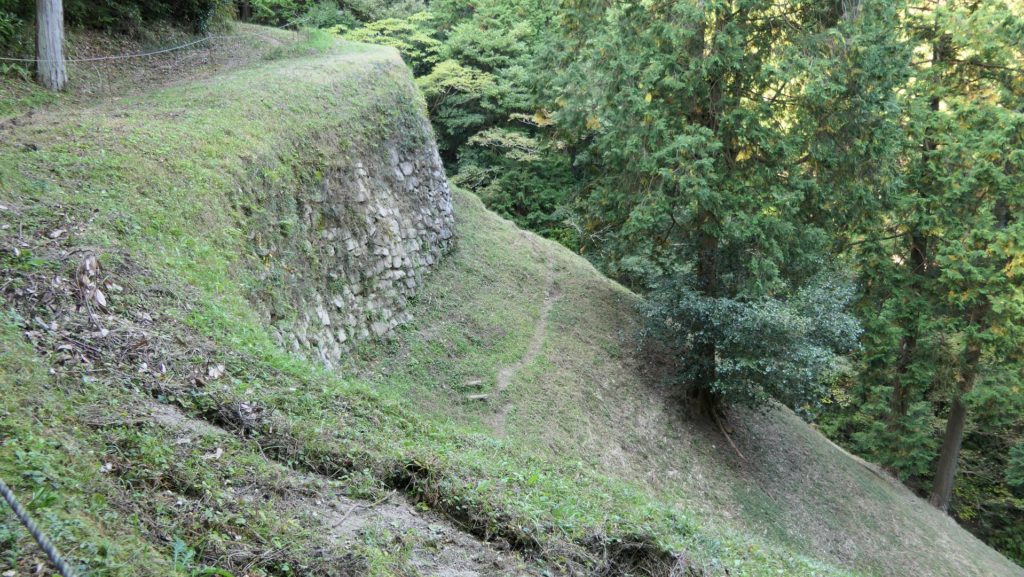
その後~Later History
城の設立から約1世紀後、774年に城跡の上に四天王寺が創建されました。その当時新羅が日本を呪っていると言われていたため、それに対抗する祈りをこの寺で行ったのです。現在の山の名前はこの寺を由来としています。また「増長天」という建物の遺跡名は四天王のうちの一神を指します。戦国時代には山の中腹に岩屋城が築かれました。江戸時代には人々は多くの石仏を作り、信仰していました。最終的には城跡は1953年に国の史跡に指定されます。
About one century after the foundation of the castle, the Four Devas or Shitennoji Temple was founded on the castle ruins in 774. The temple was for praying against Silla that was said to have cursed Japan. The mountain became a castle for praying. The present name of the mountain comes from the temple. The name of the building ruins “Zochoten” is one of the four Devas. In the Warring States or Sengoku Period, Iwaya Castle was built on the mid-slope of the mountain. In the Edo Period, people made a lot of stone figures of the Buddha and prayed them. The ruins were finally designated as a National Historic Site in 1953.
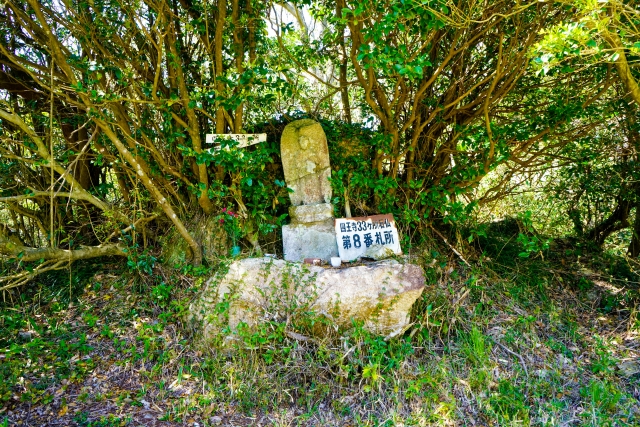
私の感想~My Impression
少なくとも百閒石垣は見ていただきたいです。1350年以上のもの間、このような石垣が生き残ってきたことに驚きを感じます。実際にご覧いただければ、この石垣がまだまだ頑丈であることがわかると思います。当方もいつの日か1日かけて城跡全体を歩いてみたいです。
I recommend you to at least see Hyakken stone walls. You can also see it’s surprising that such stone walls have survived for over 1350 years. The stone walls still look very strong when you look at them. I also think that I will spend a day walking around all the ruins sometime.
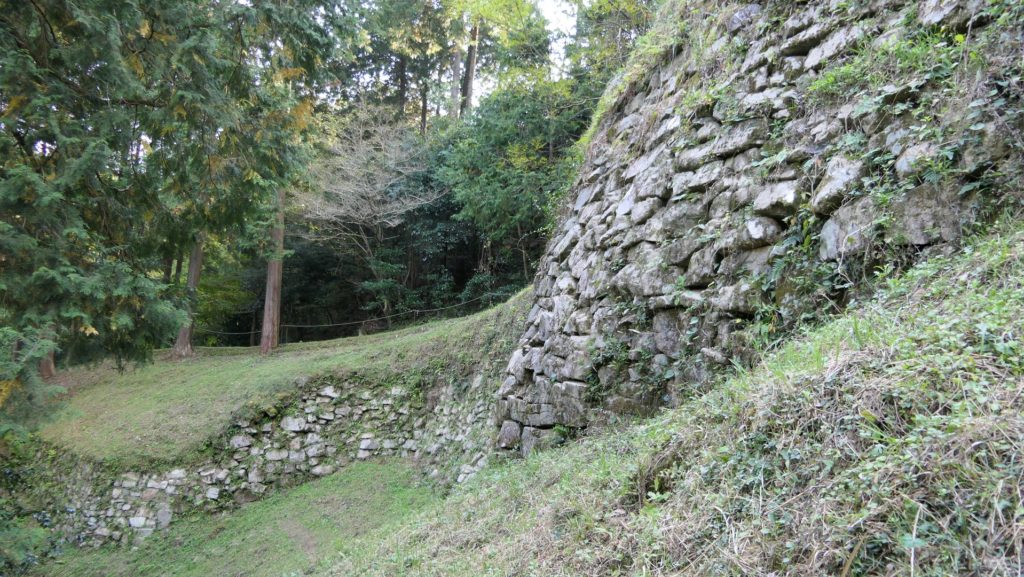
ここに行くには~How to get There
城跡に行くには、車を使われることをお勧めします。
九州自動車道の大宰府ICから約5kmです。
I recommend you to go there by car.
The ruins are around 5 km away from the Dazaifu IC on Kyushu Expressway.
リンク、参考情報~Links and References
・大野城跡、大野城市(Onojo City Website)
・大野城跡、宇美町(Umi Town Website)
・「マンガ版大野城物語」古代山城サミット実行委員会(Japanese Comic)

